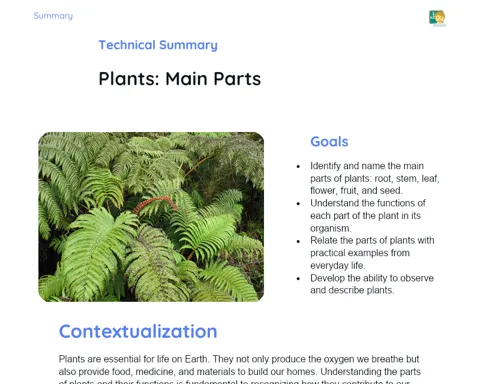Introduction
Relevance of the Theme
Earth's Layers form the basis of the Earth's Crust, a thin strip that houses all our oceans and continents. They are responsible for Earth's behavior, including earthquakes, volcanic activities, and continental drift. Understanding the Earth's internal structure and its layers is essential to comprehend geology, geography, and even the natural resources we use in our daily lives.
Contextualization
Earth's Layers are the first stop in the study of Geology, a fundamental science that focuses on the study of rocky planets. In the 6th-grade Science curriculum of Elementary School, Earth's Layers mark the transition from the study of the Earth's surface to the exploration of its internal processes. The information gathered here will be used later to understand topics such as mountain formation, the rock cycle, and even the interpretation of natural phenomena.
Theoretical Development
Components
-
Earth's Crust: It is the outermost and thinnest layer of the Earth, mainly composed of rocks and soils. It has an average thickness of 30 km beneath the continents and 5 km beneath the oceans. This layer is where we live and where our cities, rivers, and oceans are located.
-
Mantle: Just below the Crust is the Mantle. It is a rocky layer that extends to about 2,900 km in depth. The mantle is divided into two sections: upper and lower. The upper part is solid, while the lower part is almost liquid due to the high temperatures and pressures inside the Earth.
-
Core: The Core is the innermost and hottest layer of the Earth, divided into Outer Core and Inner Core. It is mainly composed of iron, with some heavy elements like nickel and cobalt. The outer core is liquid, while the inner core is solid due to extreme pressure.
Key Terms
-
Geology: Scientific study of the materials and processes that make up the Earth.
-
Plate Tectonics: Geological theory that explains the formation and movement of rock blocks, known as tectonic plates, on the Earth's surface.
-
Continental Drift: Theory proposed by Alfred Wegener in 1912, which argues that continents move slowly over time.
Examples and Cases
-
Earthquakes and Volcanoes: The structure of the Earth's layers is directly related to the occurrence of earthquakes and volcanoes. Earthquakes happen when tectonic plates, located in the Crust, collide or move. Volcanic activity is caused when magma, formed in the Mantle, rises towards the Earth's surface.
-
Continental Drift: The Continental Drift theory suggests that continents, which are seated on the Earth's crust, move slowly. This movement is possible because the crust floats on the Mantle, which is denser.
Detailed Summary
Key Points
-
Definition of Earth's Layers: The Earth's layers are stratified compositions that differ in terms of chemical composition, temperature, and physical state. The Earth is understood to have a structure in three main layers: Earth's Crust, Mantle, and Core.
-
Earth's Crust: It is the outermost and thinnest layer of the planet. It is unevenly distributed, being thicker beneath the continents (30 km on average) and thinner under the oceans (5 km). It is where all the geographical elements we know and inhabit are located.
-
Mantle: Situated just below the Earth's Crust and extending to approximately 2,900 km in depth. It is divided into the Upper Mantle, which is solid, and the Lower Mantle, which has physical properties more similar to a liquid due to extreme pressure and temperature conditions. It is in the Lower Mantle that material convection begins.
-
Core: The innermost and hottest layer of the Earth, composed of the Outer Core and Inner Core. The Outer Core is liquid, while the Inner Core is solid. Its high temperature is attributed to both the Earth's formation energy (heat added from the planet's formation), radioactive sources, and mainly energy released by the Inner Core's crystallization.
-
Practical applications of knowledge about Earth's layers include understanding events such as earthquakes (resulting from the movement of tectonic plates in the Earth's Crust) and volcanic activities (caused by the movement of magma from the Mantle to the Crust).
-
Key Terms essential for understanding this topic are Geology, Plate Tectonics, and Continental Drift. Geology is the science that studies the Earth, while Plate Tectonics and Continental Drift are theories that respectively explain the movement of tectonic plates (located in the Crust) and the movement of continents (located in the Crust).
Conclusions
-
Earth's composition is dynamic. Through the study of Earth's Layers, we realize that our planet is a living entity, with internal processes constantly changing. Earthquakes, volcanoes, mountain formation, and even the movement of continents are direct results of the interaction between Earth's layers.
-
Earth's formation shapes the world as we know it. The way Earth's layers interact and behave - particularly the movement of tectonic plates - has a direct impact on the formation of geographical, biological, and even climatic features on our planet.
Exercises
- Identify Earth's layers in a diagram. Draw a diagram representing the Earth's internal structure and indicate each of the layers - Earth's Crust, Mantle (upper and lower), and Core (outer and inner).
- Relate Earth's layers to natural phenomena. Choose a natural phenomenon, such as an earthquake or volcano, and explain which Earth's layers are involved in its occurrence.
- Associate key terms with concepts. Write a brief paragraph about Plate Tectonics and Continental Drift, explaining the central idea of each and how they are related to the study of Earth's Layers.



